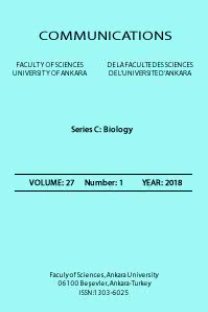SYNTHESIS OF OPEN-CHAIN SUGAR DERIVATIVES AS ANTICANCER AND ANTIMICROBIAL AGENTS
Carbohydrate derivatives, lectins, Anticancer, Antibacteri
___
Gabius H (2018). The sugar code: Why glycans are so important. Biosystems 164: 102–111.Zhang Y, Chan JW, Moretti A, Uhrich KE (2015). Designing polymers with sugar-based advantages for bioactive delivery applications. Journal of Controlled Release 219: 355–368.
Drickamer K, Taylor ME (2015). Recent insights into structures and functions of C-type lectins in the immune system. Current Opinion in Structural Biology 34: 26–34.
Schwardt O, Rabbani S, Hartmann M, Abgottspon D, Wittwer M, Kleeb S, Zalewski A, Smieško M, Cutting B, Ernst B (2011). Design, synthesis and biological evaluation of mannosyl triazoles as FimH antagonists. Bioorganic Medicinal Chemistry 19: 6454–6473.
Sippelli S (2016). New mannose derivatives : The tetrazole analogue of mannose-6-phosphate as angiogenesis inhibitor. Bioorganic Medicinal Chemistry Letters 26: 636–639.
Fokt I, Szymanski S, Skora S, Cybulski M, Madden T, Priebe W (2009). D -Glucose- and D -mannose-based antimetabolites . Part 2 . Facile synthesis of 2-deoxy-2-halo- D -glucoses and - D -mannoses. Carbohydrate Research 344: 1464–1473.
Lian S, Su H, Zhao B, Liu W, Zheng L, Miao J (2009). Synthesis and discovery of pyrazole-5-carbohydrazide N-glycosides as inducer of autophagy in A549 lung cancer cells. Bioorganic Medicinal Chemistry 17: 7085–7092.
Hajdúch M, Petruš L. Synthesis and cytotoxicity of some D -mannose click conjugates with aminobenzoic acid derivatives. Carbohydrate Research, 361: 1–6.
Yazgan I (2016). Novel Poly (amic) Acid Membrane Chemistries with Experimentally-controlled Pore size, Transport and Disinfection Properties, State University of New York at Binghamton.
Stokmaier D, Khorev O, Cutting B, Born R, Ricklin D, Ernst TOG, Böni F, Schwingruber K, Gentner M, Wittwer M, Spreafico M, Vedani A, Rabbani S, Schwardt O, Ernst B (2009). Design, synthesis and evaluation of monovalent ligands for the asialoglycoprotein receptor ( ASGP-R ). Bioorganic Medicinal Chemistry 17: 7254–7264.
Ahmed T, Shahid M, Azeem F, I. Rasul, Shah AA, Noman M, Hameed A, Manzoor N, Manzoor I, Muhammad S (2018). Biodegradation of plastics: current scenario and future prospects for environmental safety. Environmental Science and Pollution Research 25(8): 7287-7298.
Alsalahy MM, Almehy GF, Hendy RM, Mohammad RS, Mahmoud Y (2017). Mannose binding lectin in patients with pulmonary tuberculosis : Active and inactive. The Egyptian Journal of Chest Diseases and Tuberculosis 66: 413–418.
Naguib MM, Al MM, Al GF, El MM (2015). Study of mannose-binding lectin in smokers with and without COPD. The Egyptian Journal of Chest Diseases and Tuberculosis 64: 387–393.
Ghazarian H, Idoni B, Oppenheimer SB (2011). A glycobiology review : Carbohydrates , lectins and implications in cancer therapeutics. Acta Histochemica 113: 236–247.
Song L, Wu Tang J, Owusu L, Sun MZ, Wu J, Zhang J (2014). Galectin-3 in cancer. Clinica Chimica Acta 431:185–191.
Yazgan I, Noah NM, Toure O, Zhang S, Sadik OA (2014). Biosensor for selective detection of E. coli in spinach using the strong affinity of derivatized mannose with fimbrial lectin. Biosensors and Bioelectronics 61: 266-273.
Yazgan I, Zhang J, Kariuki VM, Akgül A, Cronmiller L, Akgül A, Mcmahon A, Gao Y, Eshun G, Choi S, Sadik OA (2018). Selective Sensing and Imaging of Penicillium italicum Spores and Hyphae using Carbohydrate-Lectin Interactions. ACS Sensors 3: 648–654.
- ISSN: 1303-6025
- Yayın Aralığı: Yılda 2 Sayı
- Başlangıç: 1943
- Yayıncı: Ankara Üniversitesi
THE FIRST RECORD OF CREPIDOTUS CROCOPHYLLUS FROM TURKEY
Deniz ALTUNTAŞ, İlgaz AKATA, Hakan ALLI
INVESTIGATION OF THE ANTIMICROBIAL ACTIVITY OF Vitis vinifera L. BOĞAZKERE
SKULL SEXUAL DIMORPHISM APPEARS IN TOY RABBITS
Pere M. PARÉS-CASANOVA, Lluis LLOVERAS, Jesus NADAL
ROLE OF SODIUM NITROPRUSSIDE ON MITIGATION OF SALT STRESS IN SWEET CORN
Fateme MANSHOORI, Mohammad ARMIN, Hamid MARVI
PUTRESCINE AS A PROTECTIVE MOLECULE ON DNA DAMAGE AND DNA METHYLATION CHANGES IN WHEAT UNDER DROUGHT
Esra ARSLAN, Guleray AGAR, Murat AYDIN
BIOLOGICAL ACTIVITIES OF ADIANTUM CAPILLUS-VENERIS COLLECTED FROM DUHOK PROVINCE (IRAQ)
Falah Saleh MOHAMMED, Mustafa SEVİNDİK, Celal BAL, Hasan AKGÜL, Zeliha SELAMOGLU
SYNTHESIS OF OPEN-CHAIN SUGAR DERIVATIVES AS ANTICANCER AND ANTIMICROBIAL AGENTS
INVESTIGATION OF MYXOMYCETES (MYXOMYCOTA) IN KIRIKHAN (HATAY PROVINCE)
